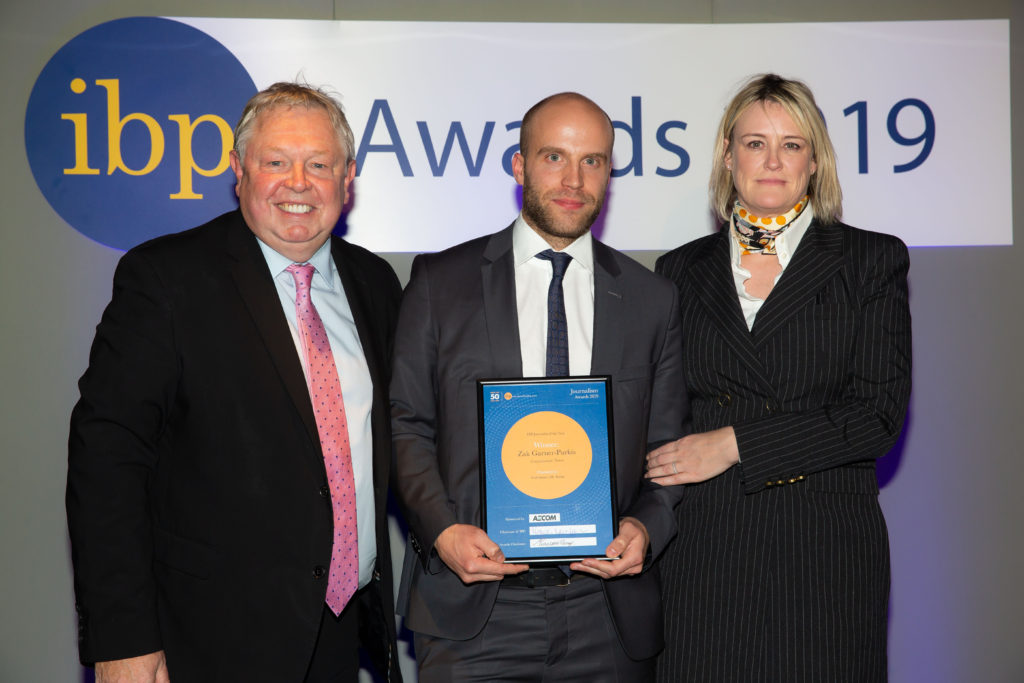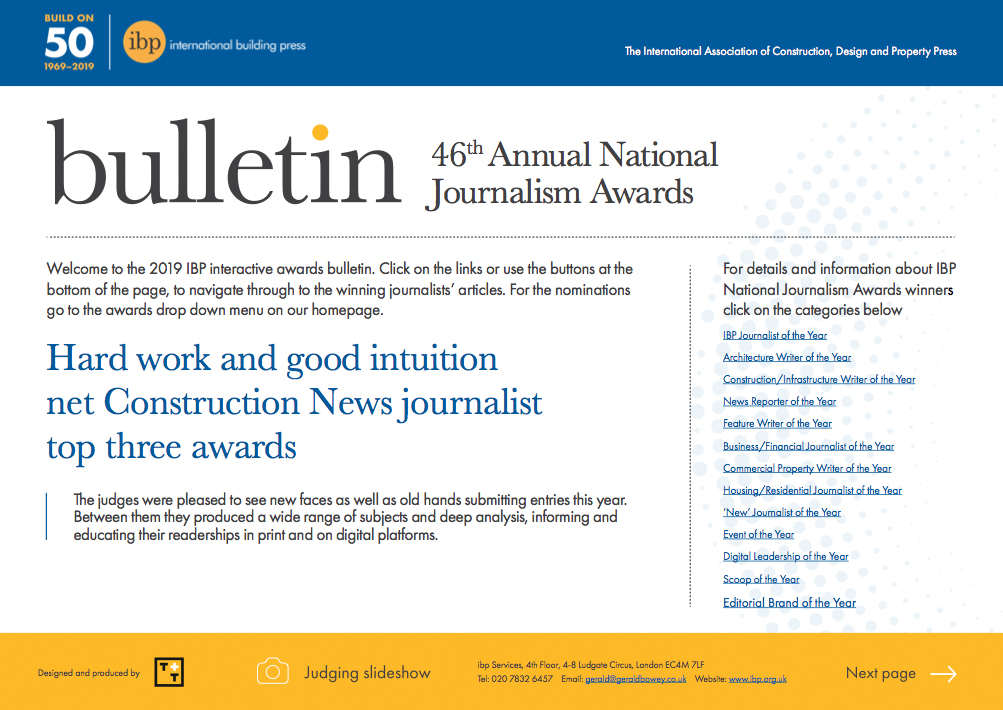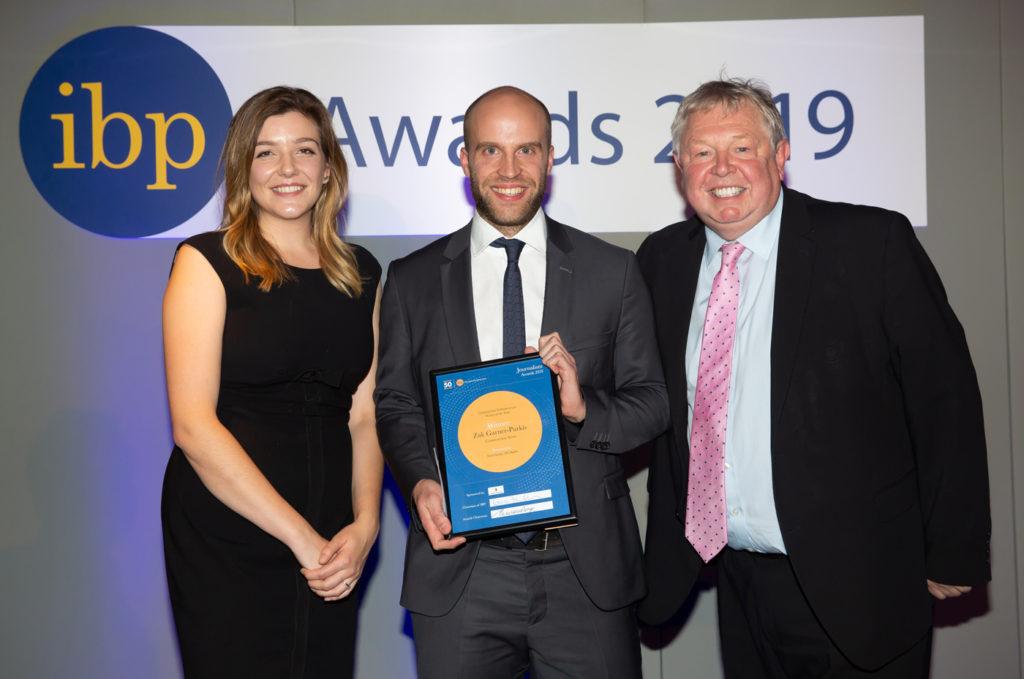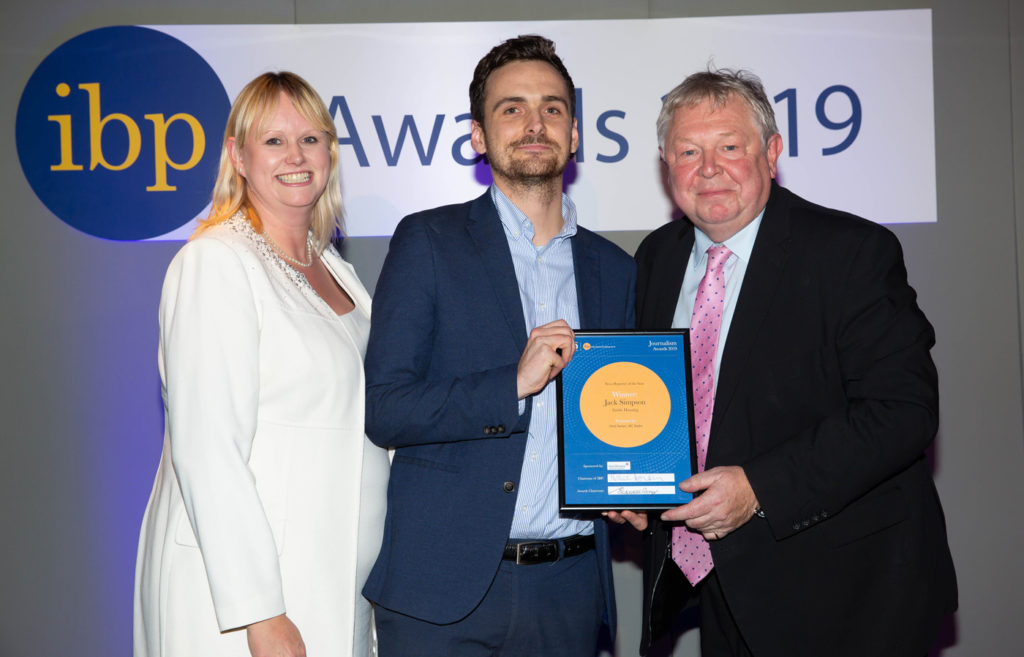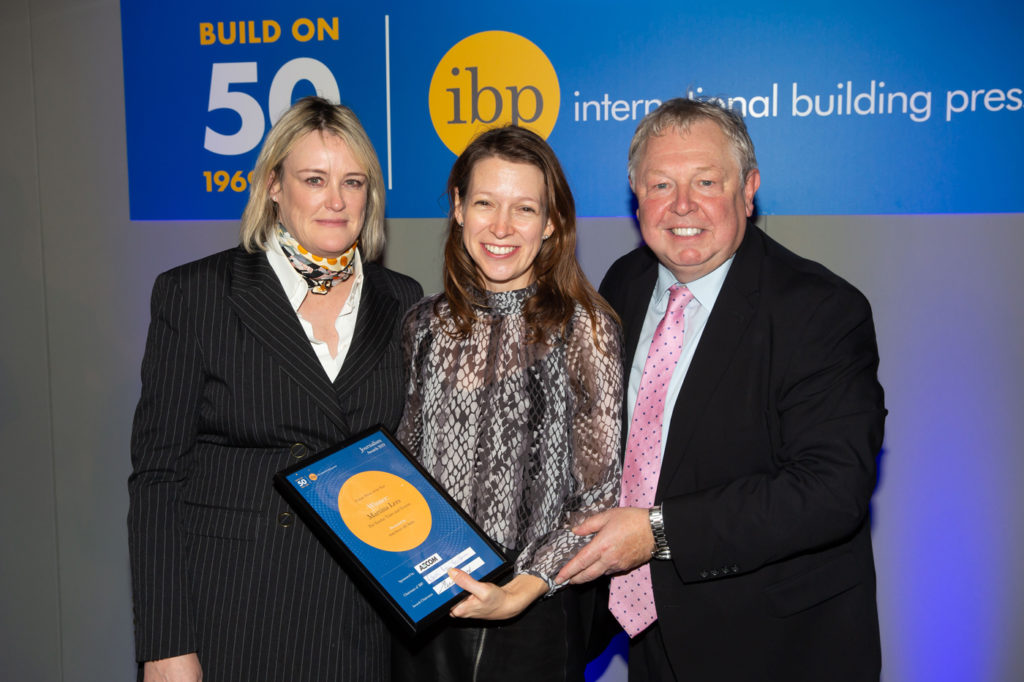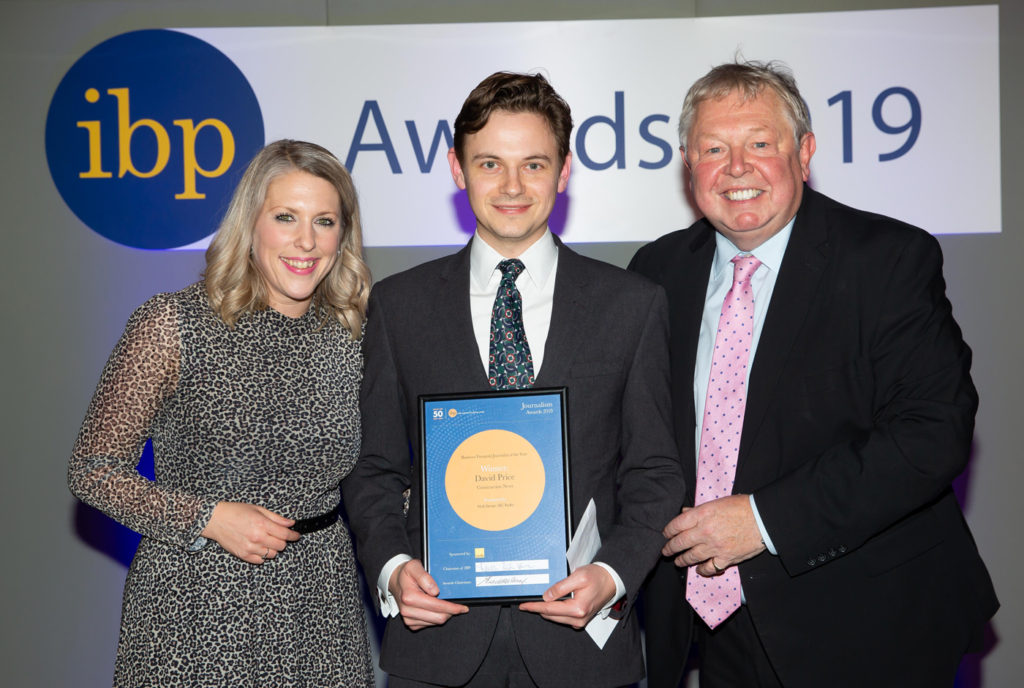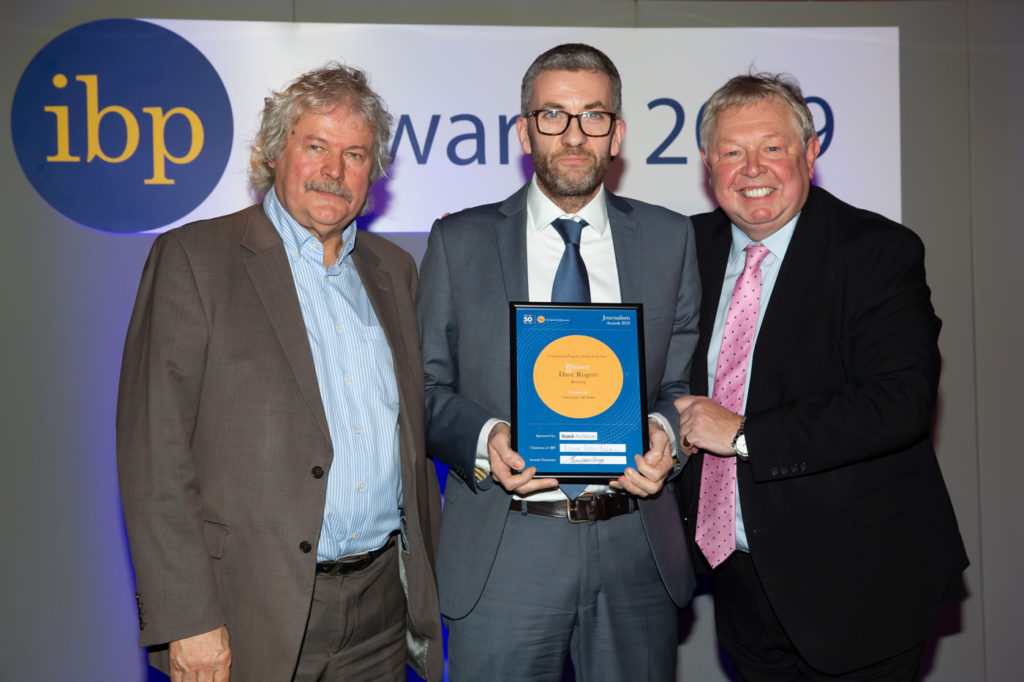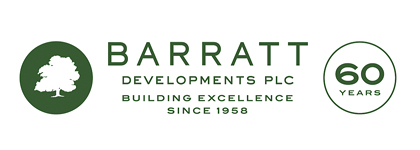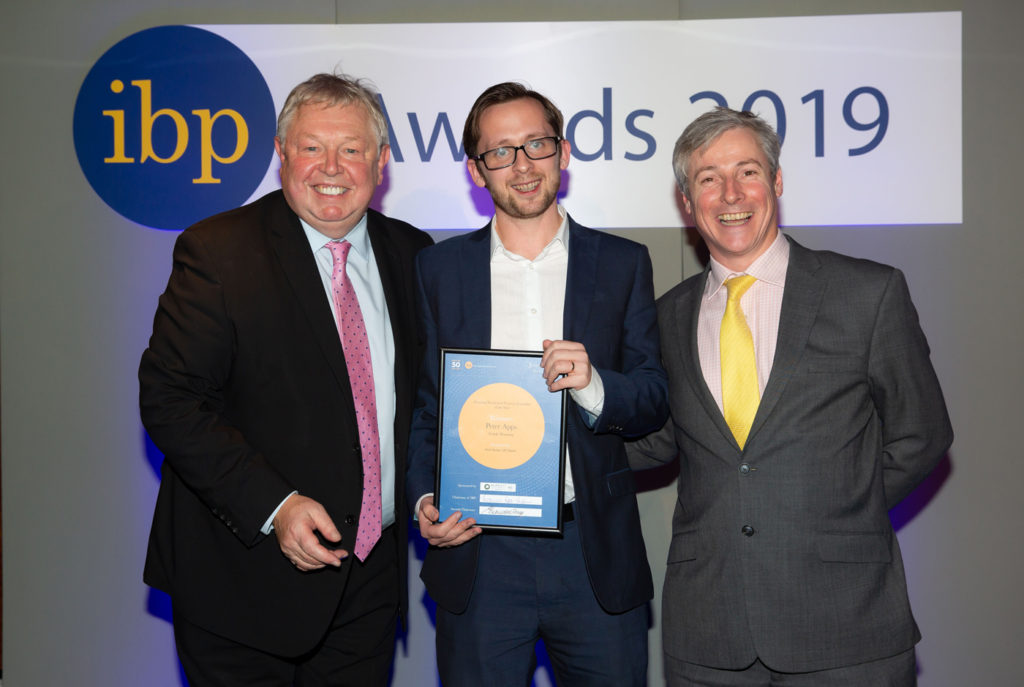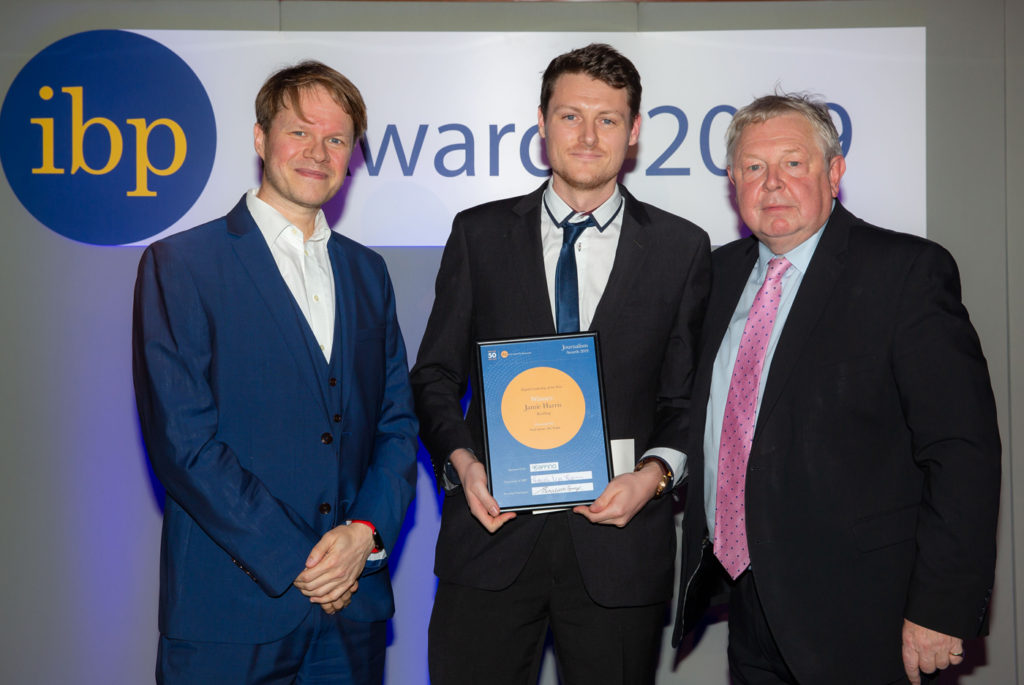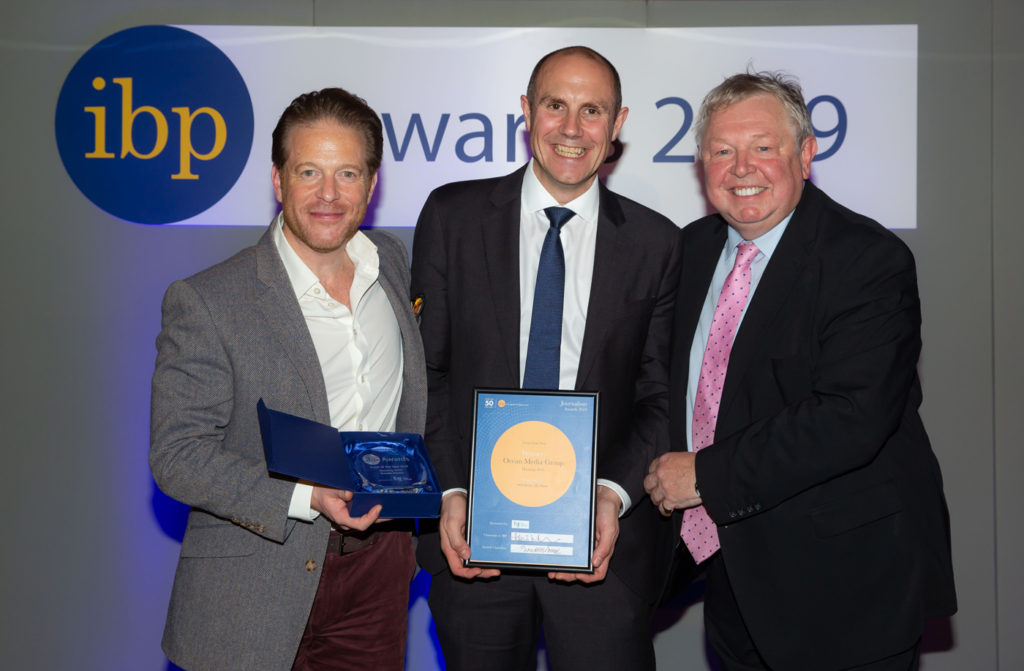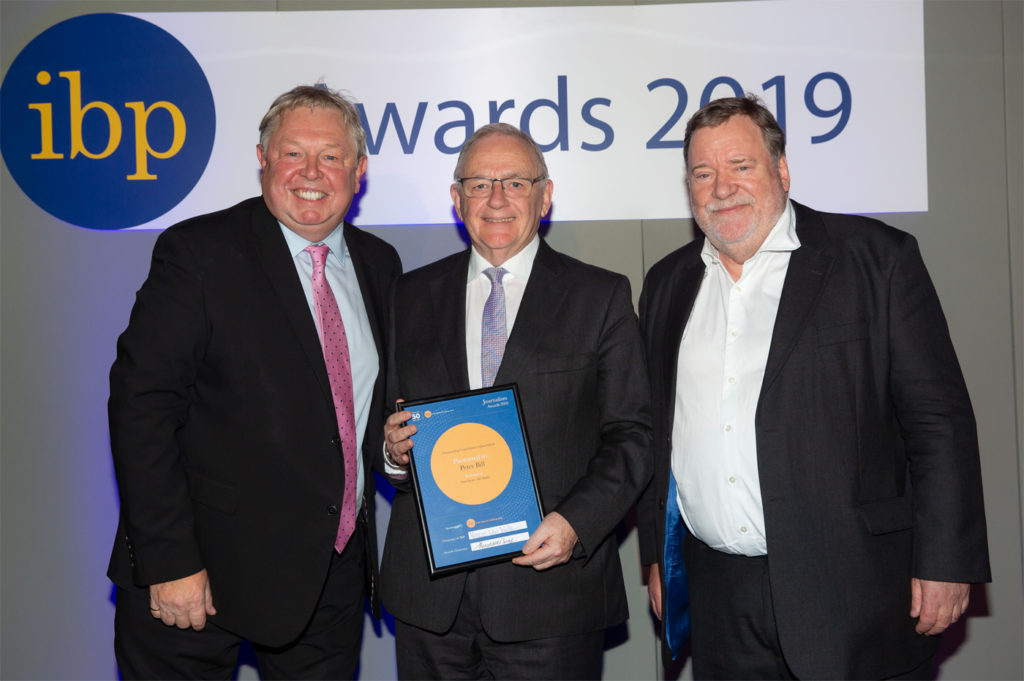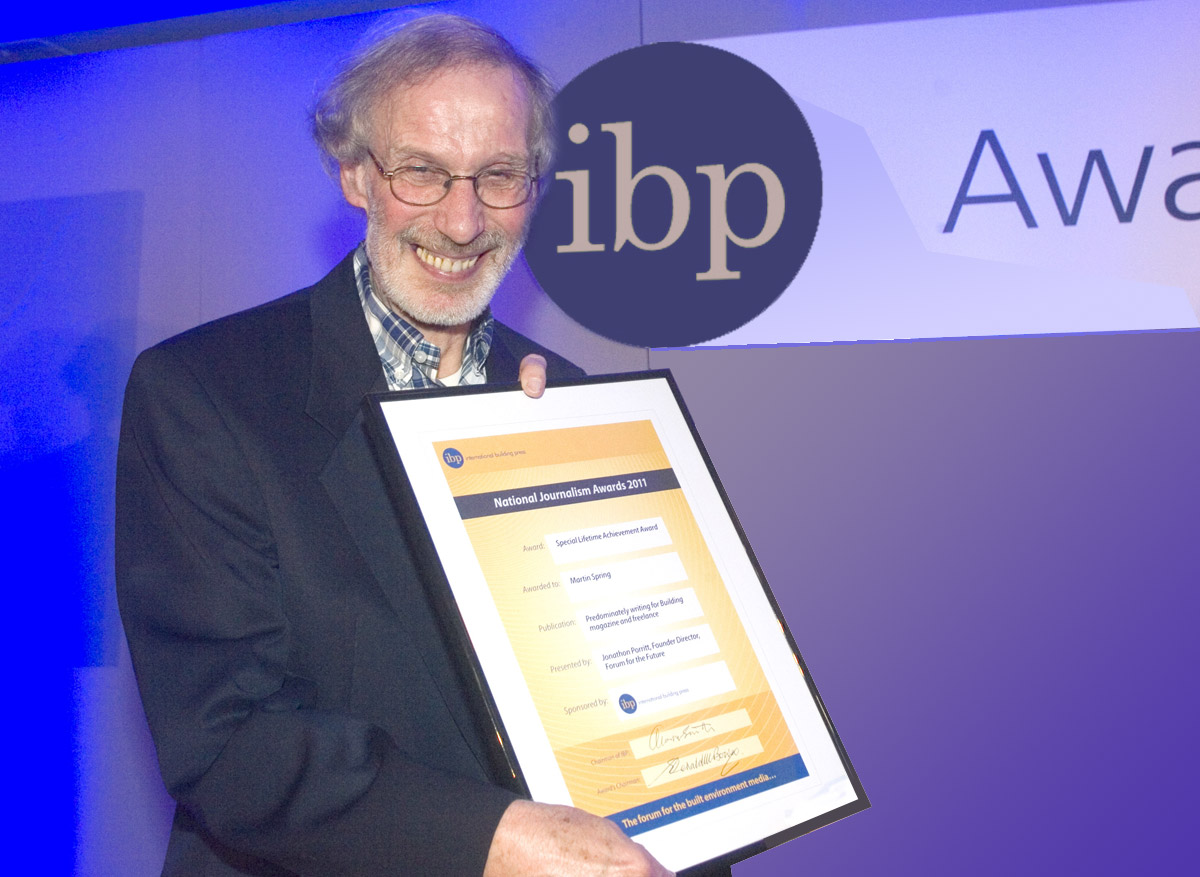IBP Journalism Awards 2019: Full Results, Nominations and Entries
CLICK HERE to download the full report in the IBP Awards 2019 Bulletin
Click on any of the arrows next to a Winner or nominated journalist’s name to access and view their entries.
ARCHITECTURE WRITER OF THE YEAR
Sponsored by BDP
 Isabelle Priest, RIBA Journal - WINNER
Isabelle Priest, RIBA Journal - WINNER
 Will Hurst, The Architects’ Journal - HIGHLY COMMENDED
Will Hurst, The Architects’ Journal - HIGHLY COMMENDED
 Ike Ijeh, Buildlng Design - COMMENDED
Ike Ijeh, Buildlng Design - COMMENDED
 Tom Ravenscroft, Dezeen
Tom Ravenscroft, Dezeen
 View video of winners presentation
View video of winners presentation
Click to view Judges' Comments
ARCHITECTURE WRITER OF THE YEAR
Writers in this category delivered some extraordinary detailed, well-observed and lyrical features on structures and buildings from all over the world. They brought their subjects to life by weaving in history with technical details and probing interviews and stylish writing.
Isabelle Priest, RIBA Journal – WINNER
This is a journalist with a distinctive voice. Isabelle writes with confidence and style. Her writing throughout is lean and vivid, full of detailed description. Her submissions show versatility and empathy with her subject matter, but the confidence and maturity to voice a strong opinion on political aspects and the impact of her stories.
Will Hurst, The Architects’ Journal – HIGHLY COMMENDED
Will delivers excellent campaigning features on subjects of global importance and vital to architectural design. He is not afraid to upbraid readers yet is never preachy in tone. There is a strong message throughout his articles.
Ike Ijeh, BD – COMMENDED
Ike writes lyrically about his subjects and seamlessly marries historical and myth with technical engineering. A hugely varied set of submissions well observed and bringing architecture – old and new – to life.
Tom Ravenscroft, Dezeen
Tom brings home the importance of paying more attention to recycling buildings rather than destroying structures of merit.
CONSTRUCTION / INFRASTRUCTURE JOURNALIST OF THE YEAR
Sponsored by Willmott Dixon
 Zak Garner-Purkis, Construction News - WINNER
Zak Garner-Purkis, Construction News - WINNER
 Emily Ashwell, New Civil Engineer
Emily Ashwell, New Civil Engineer
 Elizabeth Hopkirk, BD
Elizabeth Hopkirk, BD
 Thomas Lane, Building
Thomas Lane, Building
 View video of winners presentation
View video of winners presentation
Click to view Judges' Comments
CONSTRUCTION / INFRASTRUCTURE JOURNALIST OF THE YEAR
A very competitive category again this year with entries of a consistently high standard. The comprehensive, well structured and wide ranging submissions impressed the judges with their insight and international flavor.
The skillful presentation of complex technical and sequencing information in a readily understandable form, so important in this category, was clearly evident.
The judges were impressed by the imaginative and dogged approach to research and information gathering – journalism at its best.
Emily Ashwell, New Civil Engineer
The judges praised the diverse and topical range of subjects covered by the three articles.
The well researched piece on Hinkley Point C highlighted both the scale and complexity of this huge undertaking.
The judges agreed the well structured piece on digital imagery was both informative and insightful.
Elizabeth Hopkirk, BD
Three well researched and well crafted pieces, the technical study on the North West Cambridge Housing impressed the judges who agreed that this was a well written interesting and informative piece.
The well crafted piece on ‘The Floating Church’ provided rare insight into this specialist project. The well presented range of innovative solutions held the reader’s attention throughout.
Thomas Lane, Building
Three consistently god articles the piece on St James was well researched and insightful, guiding the reader thoughtfully through this complex and highly sequence dependent project.
The piece on Mace’s rising factories – ‘One Giant Leap’ was in the judges view a compelling and enjoyable read, capturing the ambition and ingenuity of this innovative approach.
Zak Garner-Purkis, Construction News - WINNER
Three worthy articles – packed with detail and presented with passion and enthusiasm. The piece on Carilion’s silent victims was insightful and revealing.
The impact of the piece on construction’s black market drew high praise from the judges – a powerful, well sourced and well written article.
NEWS REPORTER OF THE YEAR
Sponsored by Glen Dimplex
 Jack Simpson, Inside Housing - WINNER
Jack Simpson, Inside Housing - WINNER
 Pete Apps, Inside Housing
Pete Apps, Inside Housing
 Luke Barratt, Inside Housing
Luke Barratt, Inside Housing
 View video of winners presentation
View video of winners presentation
Click to view Judges' Comments
NEWS REPORTER OF THE YEAR
Really, really strong field this year that left the judges struggling to choose a winner. All the nominated are at the leading edge of journalism in the built environment.
Pete Apps, Inside Housing
A journalist delivering to a consistently high standard, not afraid to take on senior political figures, while revealing breaking news on the sectors big issues.
Luke Barratt, Inside Housing
Very strong treatment of a hugely important issue relating to an insurance crisis in the sector, along with a shocking article about Grenfell survivors again put at risk of fire
Jack Simpson, Inside Housing - WINNER
News is about getting important information to the reader as quickly as possible. Jack acted rapidly to establish the facts about one of the most high profile incidents in the sector within 24 hours, helping industry to mobilize and respond properly to the Barking block destroy in fire.
Further pieces, including the article on London leaseholders asked to pay to remove cladding, were soundly researched and revealed details that beat the national press on urgent topics
FEATURE WRITER OF THE YEAR
Sponsored by AECOM Headline Sponsor
 Martina Lees, writing for The Sunday Times and Tortoise Media - WINNER
Martina Lees, writing for The Sunday Times and Tortoise Media - WINNER
 Richard Waite, The Architects’ Journal – HIGHLY COMMENDED
Richard Waite, The Architects’ Journal – HIGHLY COMMENDED
 Pete Apps, Inside Housing
Pete Apps, Inside Housing
 Nathaniel Barker, Inside Housing
Nathaniel Barker, Inside Housing
 Luke Barratt, Inside Housing
Luke Barratt, Inside Housing
 Zak Garner-Purkis, Construction News
Zak Garner-Purkis, Construction News
 View video of winners presentation
View video of winners presentation
Click to view Judges' Comments
FEATURE WRITER OF THE YEAR
The judges congratulate all those who submitted entries this year, a pleasing collection if well sourced, well written and well presented articles.
An impressive level of indepth research and close attention to detail was clearly evident across the wide range of topics covered.
Pete Apps, Inside Housing
The well researched pieces were of a diverse and topical nature. The powerful lessons of the Lakanal piece stood out – with new ‘facts’ building upon previous work – feeding into the Grenfell enquiry.
The judges commented that this was journalism at its best.
Nathaniel Barker, Inside Housing
Three well researched features covering a wide range of topics; the feature on the Northern Ireland housing executive was informative and impactful. With the piece in universal credit bringing to the fore the plight of those caught up in the complex process of introduction.
Luke Barratt, Inside Housing
Three well researched pieces all of a consistently high standard.
The comprehensive piece on private finance and supported housing was both informative and engaging. A hard hitting piece on Grenfell’s forgotten victims reinforced the far reaching impact of this tragic event.
Zak Garner-Purkis, Construction News
A trio of well crafted pieces each in the judge’s view thought provoking.
The indepth research evident across the features gave insight and impact to the range of topics covered. The piece on the presence of ACM cladding on some hotels and stadiums was un the judges view well structured and insightful.
Martina Lees, writing for The Sunday Times and Tortoise Media - WINNER
Three impactful articles presented in an easily absorbed, fluid style, drawing the reader in. The judges found the interview with James Brokenshire, the housing secretary, comprehensive, and insightful reflecting a good rapport between interviewer and interviewee.
The piece drawing attention to leasehold law, with added research from Sunday Times Home colleagues Helen Davies and Tom Calver, was packed with detail and delivered at pace. It gave insight to an issue affecting the lives of many with the impact clearly and powerfully expressed. A very fine piece of journalism.
Richard Waite, The Architects’ Journal – HIGHLY COMMENDED
Three interesting, well structured and well presented pieces covering a wide variety of subject matter. The article on Amin Taha’s limestone building demonstrating the writer’s ability to present stories of almost byzantine complexity with admirable clarity.
‘Can Manchester Grow and go Green’ – this powerful piece was praised by the judges. It was supported with extensive quotes, asked all the right questions and held people to account.
BUSINESS / FINANCIAL JOURNALIST OF THE YEAR
Sponsored by Savills
 David Price, Construction News - WINNER
David Price, Construction News - WINNER
 Luke Barratt, Inside Housing
Luke Barratt, Inside Housing
 Luke Cross, Social Housing
Luke Cross, Social Housing
 View video of winners presentation
View video of winners presentation
Click to view Judges' Comments
BUSINESS / FINANCIAL JOURNALIST OF THE YEAR
Business and Financial cover a wide swathe of the property sector and the entries explored the whole area, from social housing to road building. The journalists showed their specialist expertise and the best were also to explain the subjects in simple and entertaining ways to a wider readership.
Luke Barratt, Inside Housing
Luke Barratt detailed the difficulties of housing associations and its workers. He backed up good contacts with good use of Freedom of Information requests.
Luke Cross, Social Housing
Luke Cross knows the social housing sector inside out! His three articles were ahead of the pack in demonstrating who was entering the sector and what trouble it faces.
David Price, Construction News - WINNER
David Price had a good old-fashioned scoop on the collapse of Wales’s biggest builder. He told the story straight – in easily comprehended short sentences without overwriting the story. And he told it first.
His articles on the failure of the government’s prompt-payment system showed his ability to get inside a complex story but to present his conclusions simply.
COMMERCIAL PROPERTY JOURNALIST OF THE YEAR
Sponsored by Sidell Architects
 Dave Rogers, Building - WINNER
Dave Rogers, Building - WINNER
 Mark Hansford, New Civil Engineer
Mark Hansford, New Civil Engineer
 Megan Kelly, Construction News
Megan Kelly, Construction News
 View video of winners presentation
View video of winners presentation
Click to view Judges' Comments
COMMERCIAL PROPERTY JOURNALIST OF THE YEAR
The entrants for this category showed the breadth of the subject as well as an ability to explore its depth. They included penetrating interviews, detailed statistical analysis and showed how even apparently dull subjects can be made interesting through stylish writing.
Mark Hansford, New Civil Engineer
Mark submitted three pieces that showed his range – a thinking piece on the future of cities, an analysis of Crossrail 2, and an article questioning whether engineers can provide good design. He combined good writing with interesting content.
Megan Kelly, Construction News
Although relatively new to journalism, Megan writes stylishly and confidently. Her piece on the re-tarmacing of Silverstone caught the pace and speed of a job being completed against the clock.
Dave Rogers, Building - WINNER
Dave Rogers interviewed two of the drivers behind Stanhope, one of London’s most innovative developers. His article chronicled their past glories but looked to the future and, as importantly, delved into the personalities of the people behind the property.
This was a human interest piece, lightly but intellectually written.
HOUSING / RESIDENTIAL JOURNALIST OF THE YEAR
Sponsored by Barratt Developments
 Pete Apps, Inside Housing - WINNER
Pete Apps, Inside Housing - WINNER
 Jack Simpson, Inside Housing
Jack Simpson, Inside Housing
 Martina Lees, writing for The Sunday Times and Tortoise Media
Martina Lees, writing for The Sunday Times and Tortoise Media
 View video of winners presentation
View video of winners presentation
Click to view Judges' Comments
HOUSING AND RESIDENTIAL JOURNALIST OF THE YEAR
A much stronger competition this year then we have seen recently with great entries from a range of journalists. No surprises that Grenfell features across many entries with journalists holding authority and organisations to account, while getting under the surface of the long term effects.
Pete Apps, Inside Housing - WINNER
Pete offered highly thoughtful, well written and explained articles. He can communicate substantive and complex issues well. There is great human interest content in his pieces but also hard edged exclusive news.
Jack Simpson, Inside Housing
Jack presented a good range of articles with a stand-out piece on ‘waking watches’ that attracted significant wider interest.
Martina Lees,writing for The Sunday Times and Tortoise Media
Martina provided a through investigation of the scandal of freeholds and the treatment of freeholders with extensive evidence. Great writing style and high profile interviews.
DIGITAL LEADERSHIP OF THE YEAR
Sponsored by affino
 Jamie Harris, Building - WINNER
Jamie Harris, Building - WINNER
 Mark Hansford and Alexandra Wynne, New Civil Engineer
Mark Hansford and Alexandra Wynne, New Civil Engineer
 View video of winners presentation
View video of winners presentation
Click to view Judges' Comments
DIGITAL LEADERSHIP OF THE YEAR
The judges would have liked to have seen more entries to this important new category. There are digital initiatives in other categories and the judges would encourage those entrants to enter. Nevertheless, the judges congratulate the entrants who were shortlisted.
Mark Hansford and Alexandra Wynne, New Civil Engineer
Mark and Alexandra’s podcasts had decent production values and focused on a new younger audience with a conversational style that was easily accessible.
Jamie Harris, Building - WINNER
Jamie brought in a number of elements. The podcasts were tight and well-focused, the judges particularly enjoyed the Chernobyl podcast which brought to life the experience of being on the ground.
'NEW' JOURNALIST OF THE YEAR
Sponsored by The Built Environment Trust
 William Ing, Building - WINNER
William Ing, Building - WINNER
 Francis Williams, The Architects’ Journal - HIGHLY COMMENDED
Francis Williams, The Architects’ Journal - HIGHLY COMMENDED
 Megan Kelly, Construction News - COMMENDED
Megan Kelly, Construction News - COMMENDED
 View video of winners presentation
View video of winners presentation
Click to view Judges' Comments
NEW JOURNALIST JOURNALIST OF THE YEAR
There was a huge variety of stories and styles in this category – all reflecting a commitment to delivering high quality journalism. The judges were impressed by how well these young journalists had grasped the complexities of the field in which they were working, building high=level sources and writing with sophistication and confidence.
IBP is delighted to be associated with the initiative created by the sponsor, The Built Environment Trust, to award a bursary to all three finalists in this category.
Each nominee will be commissioned to produce an article that explores and encourages innovation in the built environment and reflects the role of the Trust to provide support for educational, research and cultural activities.
William Ing, Building - WINNER
William Ing’s incredibly varied portfolio demonstrates the versatility of this young journalist. The features seamlessly weave technical detail and interviews with closely observed detail, that make readers feel that they are there, at the scene. Will has an eye for a story and one that generates traffic.
Megan Kelly, Construction News - COMMENDED
Megan’s varied articles demonstrates an ability to dig out a story and raise awareness on a subject of great importance. It shows patience and determination in sifting through information and data, and imagination in packaging it in an interesting and readable format.
Francis Williams, The Architects’ Journal – HIGHLY COMMENDED
Frances brings new freshness to architectural criticism. The writing is self-assured and the candidate is not afraid to voice opinions and to look at a subject critically yet fairly. The stories are eminently readable and engaging and just right for the readership.
SCOOP OF THE YEAR
Sponsored by FTI Consulting
 Zak Garner-Purkis, Construction News - WINNER
Zak Garner-Purkis, Construction News - WINNER
 Christine Murray, The Developer
Christine Murray, The Developer
 Jack Simpson, Inside Housing
Jack Simpson, Inside Housing
 View video of winners presentation
View video of winners presentation
Click to view Judges' Comments
SCOOP OF THE YEAR
Breadth of coverage and dogged and diligent investigation characterized this category. All the entries involved hard graft and determined digging.
Zak Garner-Purkis, Construction News - WINNER
The impact of this story on the allegations behind the delays to Tottenham Hotspur’s £850m stadium was huge – with broadsheet, broadcast as well as tabloid pick-up. The digital pick-up was enormous, beating all former records. The headline – grabbing drink and drugs features of the story summing up wider problems on site.
Christine Murray, The Developer
A detailed and through investigation revealing 98% of councils in the UK are using glyphosate-based weedkillers on playgrounds and housing estates the impact of which is potentially universal.
Jack Simpson, Inside Housing
On the ground reporting of the Barking fire-risk assessment, winning the trust of residents, resulting in a scoop followed up by the BBC and the Guardian. Inside Housing continues to be at the cutting edge of fire safety issues, alerting readers and authorities of the dangers wooden cladding months before the Barking fire.
EVENT OF THE YEAR
Sponsored by Live Group
 Housing 2019, Ocean Media - WINNER
Housing 2019, Ocean Media - WINNER
 Build to Rent, Bisnow
Build to Rent, Bisnow
 Festival of Place, The Developer
Festival of Place, The Developer
 View video of winners presentation
View video of winners presentation
Click to view Judges' Comments
EVENT OF THE YEAR
The final scoring saw these three nominees’ neck and neck, showing the strong competition in this fledgling award. Although hoping for more entries in future, all the judges were impressed with the variety and creativity on display in the submissions. Bold ideas, powerful return on investment and a clearly defined purpose shone through, vital in this category.
Build to Rent, Bisnow
Value took centre stage in the judges’ comments with the panel all remarking on how superbly the budget had been used to maximise the experience for the delegates. This created the perfect environment for an exchange of ideas between the Private and Public sector.
Of particular note was the use of a ‘stage in the round’ putting the panel of speakers in the very heart of the audience.
Festival of Place, The Developer
The judges praised the commitment to generating an engaging and fun atmosphere for all delegates, creating an experience to remember. Content shone through here with the Festival of Place tackling a range of topics to deliver something valuable for people to take home with them.
The judges commented that they can’t wait to see what happens in future with a content plan used to push the messages long after the event has closed.
Housing 2019, Ocean Media - WINNER
The judges were impressed with the sheer number of moving parts that needed to be kept perfectly whirring away for Housing 2019. From high-profile VIP speakers through to an effortless badging process, no detail had been overlooked.
The judges noted that it was only by making every aspect of the event run like clockwork that a powerful return on investment could be delivered. This created a sustainable conference programme, ready to run for many years into the future.
EDITORIAL BRAND OF THE YEAR
Sponsored by Marley
 Dezeen - Winner
Dezeen - Winner
 The Developer - Highly Commended
The Developer - Highly Commended
 New Civil Engineer
New Civil Engineer
 View video of winners presentation
View video of winners presentation
Click to view Judges' Comments
EDITORIAL BRAND OF THE YEAR
In the inaugural year of this category the judges were delighted to be able to select a strong shortlist. There are a lot of new ideas and an enduring commitment to good journalism and the target audience.
The Architects’ Journal
AJ was vibrant and both inward and outward looking to the industry. AJ is a well coordinated offering. The judges particularly liked the wake-up call and the refurb first initiative.
Building
The judges were particularly impressed by the Chernobyl story and podcast, and by the initiative to invite young professionals to take over the magazine.
Dezeen - WINNER
Dezeen taps into the zeitgeist, really understands its audience and has well-planned and original content – there was a great deal of preparation for the Bauhaus Anniversary which paid off.
The evidence is in the stats, particularly the growth on Instagram.
Inside Housing
The brand has a strong campaigning focus and serves its target audience well. There was particularly good engagement through the 100 years of social housing.
New Civil Engineer
This brand is successfully targeting different parts of its audience with different content while sticking to its core values. It continues to pack a punch with its focus on exclusives.
The Developer - HIGHLY COMMENDED
The judges welcome this ambitious new initiative which has got off to an explosive start with a 200 page magazine, its fresh take on development is recognized in events as well as an engaging website with an appealing design.
IBP JOURNALIST OF THE YEAR
Sponsored by AECOM Headline Sponsor
Zak Garner-Purkis, Construction News - WINNER
 View video of winners presentation
View video of winners presentation
Click to view Judges' Comments
IBP JOURNALIST OF THE YEAR
The judges were pleased to see new faces as well as old hands submitting entries this year. Between them they produced a wide range of subjects and deep analysis, informing and educating their readerships in print and digital platforms.
Deciding who was the best of the best in each category was often difficult, but a series of worthy winners slowly emerged – with one very deserving overall winner.
The IBP Journalist of the Year showed just how newsy the construction sector is. By hard work and good intuition, the winner dug out those stories, searching for sources or using Freedom of Information requests to check and double check the facts.
This allowed the winner’s investigative approach to find the real victims and to expose wrong doing in the industry. But the winner really scored in revealing the building of Tottenham Hotspurs stadium – drugs and drink included. This was journalism at its best.
CLICK HERE to download the full report in the IBP Awards 2019 Bulletin
Click on any of the arrows next to a Winner or nominated journalist’s name to access and view their entries.
ARCHITECTURE WRITER OF THE YEAR
Sponsored by BDP
![]() Isabelle Priest, RIBA Journal - WINNER
Isabelle Priest, RIBA Journal - WINNER![]() Will Hurst, The Architects’ Journal - HIGHLY COMMENDED
Will Hurst, The Architects’ Journal - HIGHLY COMMENDED![]() Ike Ijeh, Buildlng Design - COMMENDED
Ike Ijeh, Buildlng Design - COMMENDED![]() Tom Ravenscroft, Dezeen
Tom Ravenscroft, Dezeen
![]() View video of winners presentation
View video of winners presentation
Click to view Judges' Comments
ARCHITECTURE WRITER OF THE YEAR
Writers in this category delivered some extraordinary detailed, well-observed and lyrical features on structures and buildings from all over the world. They brought their subjects to life by weaving in history with technical details and probing interviews and stylish writing.
Isabelle Priest, RIBA Journal – WINNER
This is a journalist with a distinctive voice. Isabelle writes with confidence and style. Her writing throughout is lean and vivid, full of detailed description. Her submissions show versatility and empathy with her subject matter, but the confidence and maturity to voice a strong opinion on political aspects and the impact of her stories.
Will Hurst, The Architects’ Journal – HIGHLY COMMENDED
Will delivers excellent campaigning features on subjects of global importance and vital to architectural design. He is not afraid to upbraid readers yet is never preachy in tone. There is a strong message throughout his articles.
Ike Ijeh, BD – COMMENDED
Ike writes lyrically about his subjects and seamlessly marries historical and myth with technical engineering. A hugely varied set of submissions well observed and bringing architecture – old and new – to life.
Tom Ravenscroft, Dezeen
Tom brings home the importance of paying more attention to recycling buildings rather than destroying structures of merit.
CONSTRUCTION / INFRASTRUCTURE JOURNALIST OF THE YEAR
Sponsored by Willmott Dixon
![]() Zak Garner-Purkis, Construction News - WINNER
Zak Garner-Purkis, Construction News - WINNER![]() Emily Ashwell, New Civil Engineer
Emily Ashwell, New Civil Engineer![]() Elizabeth Hopkirk, BD
Elizabeth Hopkirk, BD![]() Thomas Lane, Building
Thomas Lane, Building
![]() View video of winners presentation
View video of winners presentation
Click to view Judges' Comments
CONSTRUCTION / INFRASTRUCTURE JOURNALIST OF THE YEAR
A very competitive category again this year with entries of a consistently high standard. The comprehensive, well structured and wide ranging submissions impressed the judges with their insight and international flavor.
The skillful presentation of complex technical and sequencing information in a readily understandable form, so important in this category, was clearly evident.
The judges were impressed by the imaginative and dogged approach to research and information gathering – journalism at its best.
Emily Ashwell, New Civil Engineer
The judges praised the diverse and topical range of subjects covered by the three articles.
The well researched piece on Hinkley Point C highlighted both the scale and complexity of this huge undertaking.
The judges agreed the well structured piece on digital imagery was both informative and insightful.
Elizabeth Hopkirk, BD
Three well researched and well crafted pieces, the technical study on the North West Cambridge Housing impressed the judges who agreed that this was a well written interesting and informative piece.
The well crafted piece on ‘The Floating Church’ provided rare insight into this specialist project. The well presented range of innovative solutions held the reader’s attention throughout.
Thomas Lane, Building
Three consistently god articles the piece on St James was well researched and insightful, guiding the reader thoughtfully through this complex and highly sequence dependent project.
The piece on Mace’s rising factories – ‘One Giant Leap’ was in the judges view a compelling and enjoyable read, capturing the ambition and ingenuity of this innovative approach.
Zak Garner-Purkis, Construction News - WINNER
Three worthy articles – packed with detail and presented with passion and enthusiasm. The piece on Carilion’s silent victims was insightful and revealing.
The impact of the piece on construction’s black market drew high praise from the judges – a powerful, well sourced and well written article.
NEWS REPORTER OF THE YEAR
Sponsored by Glen Dimplex
![]() Jack Simpson, Inside Housing - WINNER
Jack Simpson, Inside Housing - WINNER![]() Pete Apps, Inside Housing
Pete Apps, Inside Housing![]() Luke Barratt, Inside Housing
Luke Barratt, Inside Housing
![]() View video of winners presentation
View video of winners presentation
Click to view Judges' Comments
NEWS REPORTER OF THE YEAR
Really, really strong field this year that left the judges struggling to choose a winner. All the nominated are at the leading edge of journalism in the built environment.
Pete Apps, Inside Housing
A journalist delivering to a consistently high standard, not afraid to take on senior political figures, while revealing breaking news on the sectors big issues.
Luke Barratt, Inside Housing
Very strong treatment of a hugely important issue relating to an insurance crisis in the sector, along with a shocking article about Grenfell survivors again put at risk of fire
Jack Simpson, Inside Housing - WINNER
News is about getting important information to the reader as quickly as possible. Jack acted rapidly to establish the facts about one of the most high profile incidents in the sector within 24 hours, helping industry to mobilize and respond properly to the Barking block destroy in fire.
Further pieces, including the article on London leaseholders asked to pay to remove cladding, were soundly researched and revealed details that beat the national press on urgent topics
FEATURE WRITER OF THE YEAR
Sponsored by AECOM Headline Sponsor
![]() Martina Lees, writing for The Sunday Times and Tortoise Media - WINNER
Martina Lees, writing for The Sunday Times and Tortoise Media - WINNER![]() Richard Waite, The Architects’ Journal – HIGHLY COMMENDED
Richard Waite, The Architects’ Journal – HIGHLY COMMENDED![]() Pete Apps, Inside Housing
Pete Apps, Inside Housing![]() Nathaniel Barker, Inside Housing
Nathaniel Barker, Inside Housing![]() Luke Barratt, Inside Housing
Luke Barratt, Inside Housing![]() Zak Garner-Purkis, Construction News
Zak Garner-Purkis, Construction News
![]() View video of winners presentation
View video of winners presentation
Click to view Judges' Comments
FEATURE WRITER OF THE YEAR
The judges congratulate all those who submitted entries this year, a pleasing collection if well sourced, well written and well presented articles.
An impressive level of indepth research and close attention to detail was clearly evident across the wide range of topics covered.
Pete Apps, Inside Housing
The well researched pieces were of a diverse and topical nature. The powerful lessons of the Lakanal piece stood out – with new ‘facts’ building upon previous work – feeding into the Grenfell enquiry.
The judges commented that this was journalism at its best.
Nathaniel Barker, Inside Housing
Three well researched features covering a wide range of topics; the feature on the Northern Ireland housing executive was informative and impactful. With the piece in universal credit bringing to the fore the plight of those caught up in the complex process of introduction.
Luke Barratt, Inside Housing
Three well researched pieces all of a consistently high standard.
The comprehensive piece on private finance and supported housing was both informative and engaging. A hard hitting piece on Grenfell’s forgotten victims reinforced the far reaching impact of this tragic event.
Zak Garner-Purkis, Construction News
A trio of well crafted pieces each in the judge’s view thought provoking.
The indepth research evident across the features gave insight and impact to the range of topics covered. The piece on the presence of ACM cladding on some hotels and stadiums was un the judges view well structured and insightful.
Martina Lees, writing for The Sunday Times and Tortoise Media - WINNER
Three impactful articles presented in an easily absorbed, fluid style, drawing the reader in. The judges found the interview with James Brokenshire, the housing secretary, comprehensive, and insightful reflecting a good rapport between interviewer and interviewee.
The piece drawing attention to leasehold law, with added research from Sunday Times Home colleagues Helen Davies and Tom Calver, was packed with detail and delivered at pace. It gave insight to an issue affecting the lives of many with the impact clearly and powerfully expressed. A very fine piece of journalism.
Richard Waite, The Architects’ Journal – HIGHLY COMMENDED
Three interesting, well structured and well presented pieces covering a wide variety of subject matter. The article on Amin Taha’s limestone building demonstrating the writer’s ability to present stories of almost byzantine complexity with admirable clarity.
‘Can Manchester Grow and go Green’ – this powerful piece was praised by the judges. It was supported with extensive quotes, asked all the right questions and held people to account.
BUSINESS / FINANCIAL JOURNALIST OF THE YEAR
Sponsored by Savills
![]() David Price, Construction News - WINNER
David Price, Construction News - WINNER![]() Luke Barratt, Inside Housing
Luke Barratt, Inside Housing![]() Luke Cross, Social Housing
Luke Cross, Social Housing
![]() View video of winners presentation
View video of winners presentation
Click to view Judges' Comments
BUSINESS / FINANCIAL JOURNALIST OF THE YEAR
Business and Financial cover a wide swathe of the property sector and the entries explored the whole area, from social housing to road building. The journalists showed their specialist expertise and the best were also to explain the subjects in simple and entertaining ways to a wider readership.
Luke Barratt, Inside Housing
Luke Barratt detailed the difficulties of housing associations and its workers. He backed up good contacts with good use of Freedom of Information requests.
Luke Cross, Social Housing
Luke Cross knows the social housing sector inside out! His three articles were ahead of the pack in demonstrating who was entering the sector and what trouble it faces.
David Price, Construction News - WINNER
David Price had a good old-fashioned scoop on the collapse of Wales’s biggest builder. He told the story straight – in easily comprehended short sentences without overwriting the story. And he told it first.
His articles on the failure of the government’s prompt-payment system showed his ability to get inside a complex story but to present his conclusions simply.
COMMERCIAL PROPERTY JOURNALIST OF THE YEAR
Sponsored by Sidell Architects
![]() Dave Rogers, Building - WINNER
Dave Rogers, Building - WINNER![]() Mark Hansford, New Civil Engineer
Mark Hansford, New Civil Engineer![]() Megan Kelly, Construction News
Megan Kelly, Construction News
![]() View video of winners presentation
View video of winners presentation
Click to view Judges' Comments
COMMERCIAL PROPERTY JOURNALIST OF THE YEAR
The entrants for this category showed the breadth of the subject as well as an ability to explore its depth. They included penetrating interviews, detailed statistical analysis and showed how even apparently dull subjects can be made interesting through stylish writing.
Mark Hansford, New Civil Engineer
Mark submitted three pieces that showed his range – a thinking piece on the future of cities, an analysis of Crossrail 2, and an article questioning whether engineers can provide good design. He combined good writing with interesting content.
Megan Kelly, Construction News
Although relatively new to journalism, Megan writes stylishly and confidently. Her piece on the re-tarmacing of Silverstone caught the pace and speed of a job being completed against the clock.
Dave Rogers, Building - WINNER
Dave Rogers interviewed two of the drivers behind Stanhope, one of London’s most innovative developers. His article chronicled their past glories but looked to the future and, as importantly, delved into the personalities of the people behind the property.
This was a human interest piece, lightly but intellectually written.
HOUSING / RESIDENTIAL JOURNALIST OF THE YEAR
Sponsored by Barratt Developments
![]() Pete Apps, Inside Housing - WINNER
Pete Apps, Inside Housing - WINNER![]() Jack Simpson, Inside Housing
Jack Simpson, Inside Housing ![]() Martina Lees, writing for The Sunday Times and Tortoise Media
Martina Lees, writing for The Sunday Times and Tortoise Media
![]() View video of winners presentation
View video of winners presentation
Click to view Judges' Comments
HOUSING AND RESIDENTIAL JOURNALIST OF THE YEAR
A much stronger competition this year then we have seen recently with great entries from a range of journalists. No surprises that Grenfell features across many entries with journalists holding authority and organisations to account, while getting under the surface of the long term effects.
Pete Apps, Inside Housing - WINNER
Pete offered highly thoughtful, well written and explained articles. He can communicate substantive and complex issues well. There is great human interest content in his pieces but also hard edged exclusive news.
Jack Simpson, Inside Housing
Jack presented a good range of articles with a stand-out piece on ‘waking watches’ that attracted significant wider interest.
Martina Lees,writing for The Sunday Times and Tortoise Media
Martina provided a through investigation of the scandal of freeholds and the treatment of freeholders with extensive evidence. Great writing style and high profile interviews.
DIGITAL LEADERSHIP OF THE YEAR
Sponsored by affino
![]() Jamie Harris, Building - WINNER
Jamie Harris, Building - WINNER ![]() Mark Hansford and Alexandra Wynne, New Civil Engineer
Mark Hansford and Alexandra Wynne, New Civil Engineer
![]() View video of winners presentation
View video of winners presentation
Click to view Judges' Comments
DIGITAL LEADERSHIP OF THE YEAR
The judges would have liked to have seen more entries to this important new category. There are digital initiatives in other categories and the judges would encourage those entrants to enter. Nevertheless, the judges congratulate the entrants who were shortlisted.
Mark Hansford and Alexandra Wynne, New Civil Engineer
Mark and Alexandra’s podcasts had decent production values and focused on a new younger audience with a conversational style that was easily accessible.
Jamie Harris, Building - WINNER
Jamie brought in a number of elements. The podcasts were tight and well-focused, the judges particularly enjoyed the Chernobyl podcast which brought to life the experience of being on the ground.
'NEW' JOURNALIST OF THE YEAR
Sponsored by The Built Environment Trust
![]() William Ing, Building - WINNER
William Ing, Building - WINNER![]() Francis Williams, The Architects’ Journal - HIGHLY COMMENDED
Francis Williams, The Architects’ Journal - HIGHLY COMMENDED![]() Megan Kelly, Construction News - COMMENDED
Megan Kelly, Construction News - COMMENDED
![]() View video of winners presentation
View video of winners presentation
Click to view Judges' Comments
NEW JOURNALIST JOURNALIST OF THE YEAR
There was a huge variety of stories and styles in this category – all reflecting a commitment to delivering high quality journalism. The judges were impressed by how well these young journalists had grasped the complexities of the field in which they were working, building high=level sources and writing with sophistication and confidence.
IBP is delighted to be associated with the initiative created by the sponsor, The Built Environment Trust, to award a bursary to all three finalists in this category.
Each nominee will be commissioned to produce an article that explores and encourages innovation in the built environment and reflects the role of the Trust to provide support for educational, research and cultural activities.
William Ing, Building - WINNER
William Ing’s incredibly varied portfolio demonstrates the versatility of this young journalist. The features seamlessly weave technical detail and interviews with closely observed detail, that make readers feel that they are there, at the scene. Will has an eye for a story and one that generates traffic.
Megan Kelly, Construction News - COMMENDED
Megan’s varied articles demonstrates an ability to dig out a story and raise awareness on a subject of great importance. It shows patience and determination in sifting through information and data, and imagination in packaging it in an interesting and readable format.
Francis Williams, The Architects’ Journal – HIGHLY COMMENDED
Frances brings new freshness to architectural criticism. The writing is self-assured and the candidate is not afraid to voice opinions and to look at a subject critically yet fairly. The stories are eminently readable and engaging and just right for the readership.
SCOOP OF THE YEAR
Sponsored by FTI Consulting
![]() Zak Garner-Purkis, Construction News - WINNER
Zak Garner-Purkis, Construction News - WINNER![]() Christine Murray, The Developer
Christine Murray, The Developer![]() Jack Simpson, Inside Housing
Jack Simpson, Inside Housing
![]() View video of winners presentation
View video of winners presentation
Click to view Judges' Comments
SCOOP OF THE YEAR
Breadth of coverage and dogged and diligent investigation characterized this category. All the entries involved hard graft and determined digging.
Zak Garner-Purkis, Construction News - WINNER
The impact of this story on the allegations behind the delays to Tottenham Hotspur’s £850m stadium was huge – with broadsheet, broadcast as well as tabloid pick-up. The digital pick-up was enormous, beating all former records. The headline – grabbing drink and drugs features of the story summing up wider problems on site.
Christine Murray, The Developer
A detailed and through investigation revealing 98% of councils in the UK are using glyphosate-based weedkillers on playgrounds and housing estates the impact of which is potentially universal.
Jack Simpson, Inside Housing
On the ground reporting of the Barking fire-risk assessment, winning the trust of residents, resulting in a scoop followed up by the BBC and the Guardian. Inside Housing continues to be at the cutting edge of fire safety issues, alerting readers and authorities of the dangers wooden cladding months before the Barking fire.
EVENT OF THE YEAR
Sponsored by Live Group
![]() Housing 2019, Ocean Media - WINNER
Housing 2019, Ocean Media - WINNER![]() Build to Rent, Bisnow
Build to Rent, Bisnow![]() Festival of Place, The Developer
Festival of Place, The Developer
![]() View video of winners presentation
View video of winners presentation
Click to view Judges' Comments
EVENT OF THE YEAR
The final scoring saw these three nominees’ neck and neck, showing the strong competition in this fledgling award. Although hoping for more entries in future, all the judges were impressed with the variety and creativity on display in the submissions. Bold ideas, powerful return on investment and a clearly defined purpose shone through, vital in this category.
Build to Rent, Bisnow
Value took centre stage in the judges’ comments with the panel all remarking on how superbly the budget had been used to maximise the experience for the delegates. This created the perfect environment for an exchange of ideas between the Private and Public sector.
Of particular note was the use of a ‘stage in the round’ putting the panel of speakers in the very heart of the audience.
Festival of Place, The Developer
The judges praised the commitment to generating an engaging and fun atmosphere for all delegates, creating an experience to remember. Content shone through here with the Festival of Place tackling a range of topics to deliver something valuable for people to take home with them.
The judges commented that they can’t wait to see what happens in future with a content plan used to push the messages long after the event has closed.
Housing 2019, Ocean Media - WINNER
The judges were impressed with the sheer number of moving parts that needed to be kept perfectly whirring away for Housing 2019. From high-profile VIP speakers through to an effortless badging process, no detail had been overlooked.
The judges noted that it was only by making every aspect of the event run like clockwork that a powerful return on investment could be delivered. This created a sustainable conference programme, ready to run for many years into the future.
EDITORIAL BRAND OF THE YEAR
Sponsored by Marley
![]() Dezeen - Winner
Dezeen - Winner![]() The Developer - Highly Commended
The Developer - Highly Commended
![]() New Civil Engineer
New Civil Engineer
![]() View video of winners presentation
View video of winners presentation
Click to view Judges' Comments
EDITORIAL BRAND OF THE YEAR
In the inaugural year of this category the judges were delighted to be able to select a strong shortlist. There are a lot of new ideas and an enduring commitment to good journalism and the target audience.
The Architects’ Journal
AJ was vibrant and both inward and outward looking to the industry. AJ is a well coordinated offering. The judges particularly liked the wake-up call and the refurb first initiative.
Building
The judges were particularly impressed by the Chernobyl story and podcast, and by the initiative to invite young professionals to take over the magazine.
Dezeen - WINNER
Dezeen taps into the zeitgeist, really understands its audience and has well-planned and original content – there was a great deal of preparation for the Bauhaus Anniversary which paid off.
The evidence is in the stats, particularly the growth on Instagram.
Inside Housing
The brand has a strong campaigning focus and serves its target audience well. There was particularly good engagement through the 100 years of social housing.
New Civil Engineer
This brand is successfully targeting different parts of its audience with different content while sticking to its core values. It continues to pack a punch with its focus on exclusives.
The Developer - HIGHLY COMMENDED
The judges welcome this ambitious new initiative which has got off to an explosive start with a 200 page magazine, its fresh take on development is recognized in events as well as an engaging website with an appealing design.
IBP JOURNALIST OF THE YEAR
Sponsored by AECOM Headline Sponsor
Zak Garner-Purkis, Construction News - WINNER
![]() View video of winners presentation
View video of winners presentation
Click to view Judges' Comments
IBP JOURNALIST OF THE YEAR
The judges were pleased to see new faces as well as old hands submitting entries this year. Between them they produced a wide range of subjects and deep analysis, informing and educating their readerships in print and digital platforms.
Deciding who was the best of the best in each category was often difficult, but a series of worthy winners slowly emerged – with one very deserving overall winner.
The IBP Journalist of the Year showed just how newsy the construction sector is. By hard work and good intuition, the winner dug out those stories, searching for sources or using Freedom of Information requests to check and double check the facts.
This allowed the winner’s investigative approach to find the real victims and to expose wrong doing in the industry. But the winner really scored in revealing the building of Tottenham Hotspurs stadium – drugs and drink included. This was journalism at its best.

